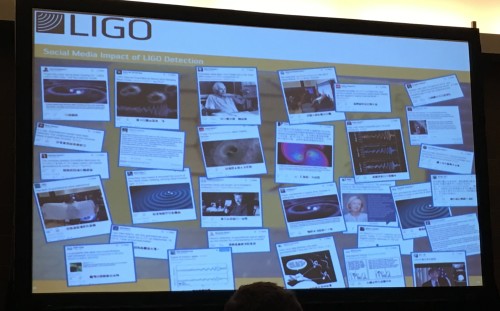Tag archives: outreach
How LIGO got the word out about gravitational waves

Tweeting to millions: LIGO made a social-media plan before announcing the detection. (Courtesy: Sarah Tesh)
By Sarah Tesh
Nowadays, social media plays a big role in communicating science to the public. It has two important qualities – it’s free and it’s international. A great case study for social media and science came last year when the Laser Interferometer Gravitational-Wave Observatory (LIGO) announced the first ever detection of gravitational waves. To tell us more about how the team grabbed the public’s attention (and got its work on Sheldon Cooper’s T-shirt in The Big Bang Theory), LIGO scientist Amber Stuver gave a witty talk at the APS March Meeting 2017 about the outreach strategy.
She began by telling us the story of that exciting detection day. Before the first detection, LIGO had published 80 papers on “detecting nothing”. Yet on 14 September 2015 – the first morning of the first day of Advanced LIGO – the much-sought-after signal appeared. The first thing that had to be done was to check it wasn’t a fake. Having detected nothing for so long, those with the knowledge to do so would sometimes “inject” results to check the system worked and keep the scientists on their toes.
View all posts by this author | View this author's profile
Newton’s apple pips to form UK orchard
By Matin Durrani
Today is not only World Science Day for Peace and Development (come on, don’t tell me you didn’t know) but also the world’s first ever International Science Center and Science Museum Day, which goes by the clunky acronym ISCSMD.
The grandiosely titled day seeks to “create new ways for our institutions to proactively address global sustainability while reaching increasingly diverse audiences”.
Building on UNESCO’s theme of “science for peace and development”, outcomes from the day’s events and discussions will be presented at the Science Centre World Summit 2017 in Tokyo next November.
View all posts by this author | View this author's profile
Quantifying the success of public engagement

Measuring up – how does one evaluate the success of outreach projects such as the dance Constant Speed? (Courtesy: Anthony Crickway)
By Matin Durrani
Here in the Physics World office our attention was caught last week by a story in the Times Higher Education. It reported on a lecture given by Simon Singh at the 2:AM conference in Amsterdam, in which the broadcaster, author and former particle physicist criticized some projects that are designed to boost the public’s interest in science, but which, he feels, are not value for money.
The story mentioned several projects facing Singh’s ire, one of which was the 2005 dance Constant Speed that was created to mark the centenary of Einstein’s annus mirabilis. It was commissioned by the Institute of Physics, which publishes Physics World, so naturally Singh’s comments piqued my interest.
Going underground to discuss alien life
By James Dacey
“Genuinely, it could be our generation that first finds life on another planet,” declared astrobiologist Lewis Dartnell last Thursday during a public talk in London. Dartnell was speaking about the possibility of life beyond Earth and what those organisms might be, based on our understanding of life here on Earth. The choice of venue – a pedestrian tunnel near King’s Cross Station bathed in neon lights – brought an appropriate alien vibe to the evening. Part of the reason for choosing the site is because if humans were to one day colonize Mars we would need to spend the first few years living underground to avoid the lethal radiation.

